Emotiki contains a number of culturally unsafe issues: the satirical use of a Polynesian deity Tiki, Tame Iti and the use of his face and tā moko without permission (only in release 1, despite their denial to Te Kaea Maori Television, here is a live link to the web archive), several other possible ethical and tikanga issues including possible Intellectual Property infringements.
Some Māori find it intolerable when their culture and images are inappropriately used, mocked with satirical images and Internet memes, but apparently not when it is made by Māori for Māori. Some Māori find it offensive that Facebook removes images of pūhoro (traditional tattooing of the upper legs and buttocks) as the images contain nudity or is of a sexual nature according to Facebook policy.
Recently Te Karere Television reported on a cultural misappropriation of online software which was being promoted for a non NZ audience on Twitter just days before. A company called Endorphina Games from Czech Republic created an online slot machine called ‘Māori’ which has Māori characters and at least one character is obviously copied from an image of Sir Pita Sharples.
In late 2016, the Christchurch Santa Parade was called “culturally insensitive” for its use of a float that was offensive to Native Indians. Eventually the float owner withdrew the float after apparently receiving death threats, and not as a result of cultural understanding by the owner, that the float was indeed inappropriate.
In June 2016, RadioNZ reported the offence caused by an American company who used Māori portraits and images of a shrunken Māori head on shower curtains, cushions and t-shirts and that after some lobbying they were removed from the web site.
In 2015 the internationally popular Internet site Reddit distributed a number of memes (an image, video, piece of text, etc., typically humorous in nature, that is copied and spread rapidly by Internet users, often with slight variations. Source Wikipedia) of Matatini national Kapa Haka competitors doing pūkana and in a number of various poses. One local radio station MoreFM were publicly reprimanded and apologised for sharing the meme’s on their web site. Māori media reported on the offence such memes caused as did mainstream media.
Being upset by the inappropriate and satirical use of cultural and religious images and knowledge is not just confined to Māori or only Indigenous Peoples.
In January 2017, the BBC reported the offence caused to India when Amazon advertised door mats featuring the Indian flag. The Indian government threatened Amazon with rescinding current visas for Amazon officials and to not grant any more visas if the product was not withdrawn.
In January 2015 a number of violent attacks occurred in France when satirical images of the prophet Muhammad were created and published by Charlie Hebdo.
In 2014 New Zealand expat Philip Blackwood, a bar manager in Myanmar Burma, was arrested and jailed after posting an image of Buddha wearing headphones on the bar’s official Facebook page. He was released from prison after a year of imprisonment.
Likewise, I would suggest that many New Zealanders would find it unacceptable and offensive if there were inappropriate and satirical images or memes of Jesus Christ or other western religious figures such as the Pope of the Roman Catholic church being published by non western Christians.
Emotiki introduction
Just prior to Christmas of 2016, a company called Te Puia, in Rotorua, who claim to have cultural approved backing from “Māori pakeke elders” have created images for use on mobile devices and labeled the app a Māori emoticon.
Emoticon: “a representation of a facial expression such as a smile or frown, formed by various combinations of keyboard characters and used in electronic communications to convey the writer’s feelings or intended tone. Source Wikipedia“.
In addition to the usage of Tiki the deity and Tame Iti face and tā moko, Emotiki have insulted traditional Māori beliefs by adding images of a head next to food, and cartooned a tourist doll while gaining wide spread support from online Māori.
Te Puia have marketed the image app as Māori emoticons despite them being mobile stickers or images that can only be copied and pasted into social media apps. Te Puia coined the term emotiki from the words emoticon and Tiki.
Te Puia state “these emoticons were New Zealand’s take on a unique Māori emoji selection. With 200 Māori and Kiwi cultural icons for people to share their kiwiana moments with each other and the world.”
After the initial release there was a number of online discussions and complaints that the emotiki were not emoticons or emoji at all, but were mobile stickers. The company agreed and quickly released an update with a disclaimer stating this as well as including several new images. In addition to the mobile stickers, the creators are selling t-shirts with the Tiki images.

About Tiki
Hei Tiki the correct term for the pendant that is used as a necklace and often called Tiki (as above) is the personification of the deity Tiki that is known by numerous names as seen below. Tiki is a recognised deity across most of Polynesia.
Depending on the tribal area, Tiki is either the creator of man (Christian equivalent of God, noting that some Iwi have a belief in a more superior god called Io or other realms) or the first man on earth (Christian equivalent of Adam).
The tiki is a personification of Tiki the fertility deity and has many incantations associated with him to assist people to become fertile, hence why people traditionally wore a Tiki. The first Tiki was made for Hineteiwaiwa the atua of childbirth and te whare pora (weaving and female arts). The shape of the Tiki represents the human embryo. This story has variations in various tribal areas, but there is unanimous agreement that Tiki is a deity or a personification of fertility.
Tiki were made from pounamu/jade (assuming this is why emotiki are green) and sometimes human skulls and whale bone which aged and became brownish (one can only assume the white and brown emotiki are to represent human skull and whale bone). Tiki were rare and highly prized heirlooms that were often handed down from generation to generation. They were crafted by tohunga and had incantations chanted in its creation and when handed from generation to generation.
Historians speculate that the English and other immigrants to New Zealand increased the production of Tiki as they were in such high demand by immigrants and thus profitable to Māori. This combined with the introduction of steel axes which made the traditional pounamu adzes redundant, re-purposed the adzes into Tiki, and at a much quicker rate than was traditionally possible. Subsequently, this made Hei Tiki less valuable due to the mass production.
Various Tiki names sourced from Elsdon Best:
- Tiki-auaha. Tiki the creator
- Tiki-auwaha. Tiki the meddler
- Tiki te po mua
- Tiki-ahua or Tiki i ahua
- Tiki-tohua. Signifies the conceiver
- Tiki-hahana Reddened, glowing, or heated Tiki
- Tiki-mumura
- Tiki-torokaha. Virile Tiki
- Tiki i apoa
- Tiki-whakaringaringa. Tiki the arm former
- Tiki-whakawaewae. Tiki the leg former
- Tiki-tawhito-ariki
- Tiki te pou roto
- Tiki-haohao
- Tiki-ahupapa
- Tiki-nui. Great Tiki
- Tiki-roa. Long Tiki
- Tiki-whaoa. Inserted Tiki
- Tiki-whatai. Projecting Tiki
Images in use by Emotiki
The satirical images depict Tiki in a number of offensive poses. Te Puia have gone to enough effort to ensure that these images are Tiki by ensuring they have the traditional three fingers and the shape of the peaked head which is a unique Taranaki region design, despite being designed by a Te Arawa company.
The usage of the Tiki in Emotik is a reminder of the 1960s and 70s, when the culturally offensive green plastic Tiki were distributed to passengers flying Air New Zealand.
The emotiki wearing a Santa hat is an act of merging a traditional Māori deity figure with another western satirical image depicting Saint Nicholas of Myra. St Nicholas was a 4th-century Greek Christian bishop of Myra in Lycia. He is now what we now recognise as Father Christmas. A disrespect for two religions and cultures to create an image that mocks Māori people and christian religion.

There was an immediate widespread online support and usage of the emotiki from Māori including Māori political leaders and Ministry of Primary Industries who posted the following offensive tweet with a deity of fertility among food of Tangaroa.
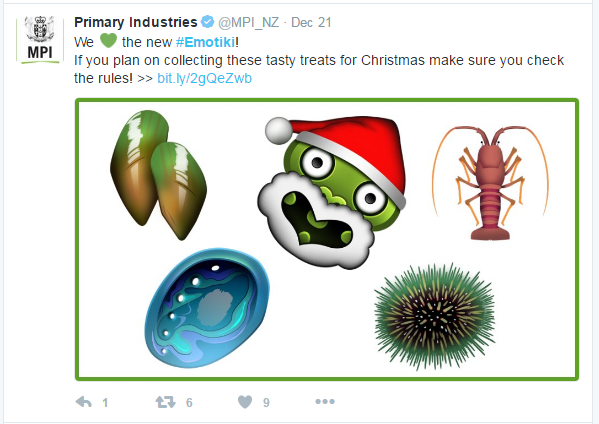
Te Puia’s own Culturally insensitive Disclaimer
In the emotiki app and on their web site is the following disclaimer:
Is Emotiki culturally insensitive?
No, we have been extremely careful to develop Emotiki with the blessing and input from Māori Pakeke elders and Te Puia staff members, with icons going through a rigorous sign-off process, to ensure accuracy and that no offense is caused. Our aim is to share our unique and precious Māori culture with the world in as many ways as possible, and working with the latest technology in messaging is another way in which we can do this.
This raises the first alert as to who these pakeke elders are? It has remnants of the Māori who were grossly underpaid to empower and enrich colonials by providing tribal histories to publish. One example is the informant to Sir George Grey and the fact that the stories were often added to with fictitious events to create larger stories. The principal informant as Ranginui Walker states in his book, the Walker Papers, being a person called Te Rake translated into English “The Rake”. Though the person may well have been a rake.
It is of concern that these elders are not named and given the appropriate dignity and recognition they deserve. Again I would suggest that this is another breach of tikanga by not showing the whakapapa of emotiki by acknowledging the kaumātua advisers. By recording whakapapa or in academic terms referencing, this gives credibility to a project.
By keeping the names unpublished, it prevents the public from knowing what advice was given and by whom. How did so many cultural issues occur without any one of the “pakeke elders” noticing it?



Other culturally offensive instances with the emotiki
- The image below contains an obvious representation of the famous Māori activist Tame Iti including his ta moko which creates another cultural issue and a copyright issue. Tame Iti was not aware of the usage of his face and tā moko. (January 2017 update: Despite Te Puia denying this was a public image, please refer to the web archive link here of the Emotiki web site from 2016, search Twitter for Emotiki and you will see others have used this image below and if you did not update your app prior to Christmas 2016, you will still this).

- The image of an old lady wearing a red cloth on her head appears to depict Te Puea Herangi of Tainui (though she wore only white head apparel) or arguably Dame Whina Cooper. Original image of Te Puea Herangi was likely copied from here.

- The images below appear to depict Māori Wardens and the females are wearing the same moko kauae as the Te Puea image and the other female images. Commentary on male ta moko below.

- The image below is very similar to the tourist Māori dolls that are available online
from several tourist web sites including http://www.giftsnz.com/dolls.htm. These were likely to have taken inspiration from the Goldie paintings of the same characters.
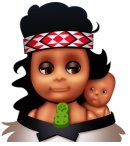
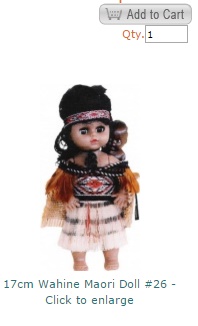
- On the main Emotiki screen are images of the deity with a human head next to a pot of food. I interpret this as the head is to eat. In the traditional Māori world the head was sacred and among other precautions, food should never be associated with or touch the head. The addition of the deity next to the head and food warrants further scrutiny.

- The faces with moko mata and moko kauae (see below) are offensive as moko is so personal to the wearer and each moko has significant sentimental and spiritual value to the wearer.
- Each female with a moko kauae has the same moko kauae. Despite the multiple offensive images, some people have changed their avatar on Twitter to a face with a moko mata and moko kauae. Perhaps more embarrassing for those people who have changed their avatar is that some of them advocate for Māori rights have changed their avatar to a lady with a moko kauae doing a pukana, despite these people not having a moko kauae in real life.
- By using these emotiki as an avatar, it is the digital equivalent of putting on a face mask of someone else’s facial skin or wearing someone else’s moko mata/moko kauae on your face as you have no idea of the meaning of the moko and no care that the moko is unique to the wearer of it. This statement has been backed up by several people I have spoken to with moko kauae and moko mata who generally state that “these people should get a real one and stop using these avatars”.
- The man doing a pukana (below and Māori wardens above) have a unique looking tā moko. I suggest that this is very similar to that of Kereopa Te Rau a notable historical figure or of an Inuit design.
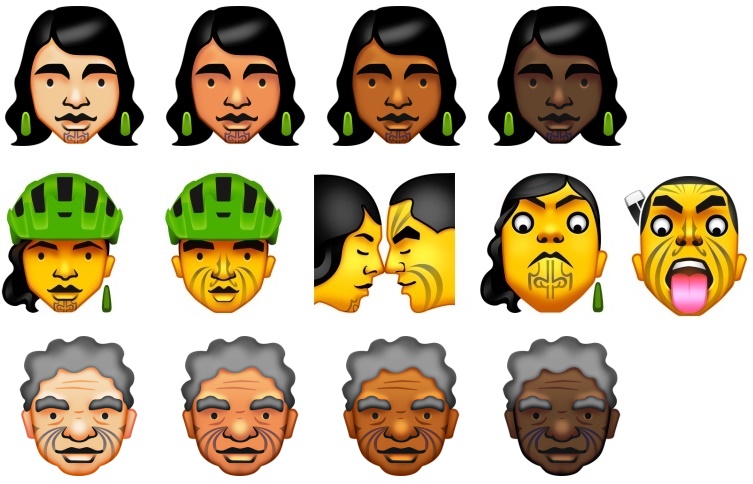
- The future risk of such stickers is that it will likely lead to an increase of images of real people, recreated as fictitious characters; tā moko, moko mata, moko kauae and various other taonga being copied without permission to enhance peoples personal collections of Māori stickers and emoticons.
- These emotiki images will likely increase in use, where the stickers are used to mock people and situations as below.
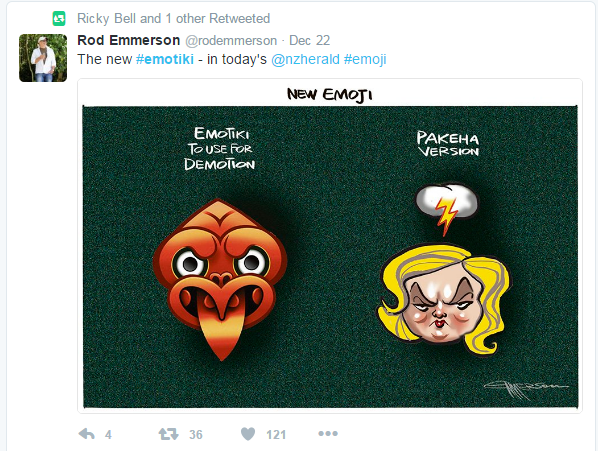
Conclusion
The principals of the emotiki is a great idea. With the right guidance this initiative could achieve the company’s ambition of bringing Māori culture into the world of emoticons/stickers.


Leave a Reply
You must be logged in to post a comment.